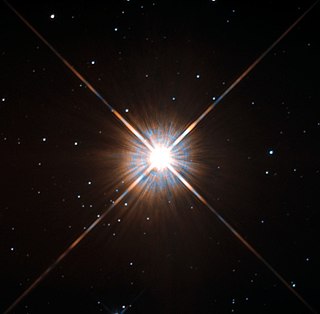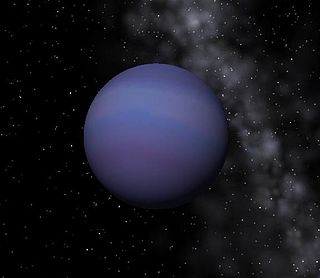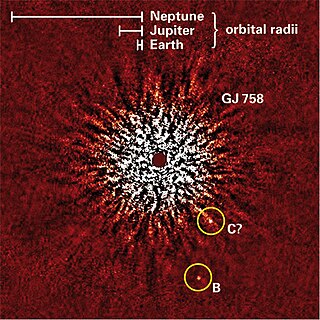
A red dwarf is the smallest kind of star on the main sequence. Red dwarfs are by far the most common type of fusing star in the Milky Way, at least in the neighborhood of the Sun. However, due to their low luminosity, individual red dwarfs cannot be easily observed. From Earth, not one star that fits the stricter definitions of a red dwarf is visible to the naked eye. Proxima Centauri, the star nearest to the Sun, is a red dwarf, as are fifty of the sixty nearest stars. According to some estimates, red dwarfs make up three-quarters of the fusing stars in the Milky Way.

Epsilon Indi, Latinized from ε Indi, is a star system located at a distance of approximately 12 light-years from Earth in the southern constellation of Indus. The star has an orange hue and is faintly visible to the naked eye with an apparent visual magnitude of 4.83. It consists of a K-type main-sequence star, ε Indi A, and two brown dwarfs, ε Indi Ba and ε Indi Bb, in a wide orbit around it. The brown dwarfs were discovered in 2003. ε Indi Ba is an early T dwarf (T1) and ε Indi Bb a late T dwarf (T6) separated by 0.6 arcseconds, with a projected distance of 1460 AU from their primary star.

A super-Jupiter is a gas giant exoplanet that is more massive than the planet Jupiter. For example, companions at the planet–brown dwarf borderline have been called super-Jupiters, such as around the star Kappa Andromedae.
HD 168443 is an ordinary yellow-hued star in the Serpens Cauda segment of the equatorial constellation of Serpens. It is known to have two substellar companions. With an apparent visual magnitude of 6.92, the star lies just below the nominal lower brightness limit of visibility to the normal human eye. This system is located at a distance of 127 light years from the Sun based on parallax, but is drifting closer with a radial velocity of −48.7 km/s.

OGLE-TR-122 is a binary stellar system containing one of the smallest main-sequence stars whose radius has been measured. It was discovered when the Optical Gravitational Lensing Experiment (OGLE) survey observed the smaller star eclipsing the larger primary. The orbital period is approximately 7.3 days. The system's primary is thought to resemble the Sun.
HD 1237 is a binary star system approximately 57 light-years away in the constellation of Hydrus.

Iota Horologii b, often catalogued HR 810 b, is an extrasolar planet approximately 56.5 light-years away in the constellation of Horologium. Iota Horologii b has a minimum mass 2.26 times that of Jupiter; astrometric measurements from Gaia suggest it has a true mass of 6.2 MJ.

109 Piscium b is a long-period extrasolar planet discovered in orbit around 109 Piscium. It is about 5.74 times the mass of Jupiter and is likely to be a gas giant. As is common for long-period planets discovered around other stars, it has an orbital eccentricity greater than that of Jupiter.
Gliese 86 is a K-type main-sequence star approximately 35 light-years away in the constellation of Eridanus. It has been confirmed that a white dwarf orbits the primary star. In 1998 the European Southern Observatory announced that an extrasolar planet was orbiting the star.
Internal heat is the heat source from the interior of celestial objects, such as stars, brown dwarfs, planets, moons, dwarf planets, and even asteroids such as Vesta, resulting from contraction caused by gravity, nuclear fusion, tidal heating, core solidification, and radioactive decay. The amount of internal heating depends on mass; the more massive the object, the more internal heat it has; also, for a given density, the more massive the object, the greater the ratio of mass to surface area, and thus the greater the retention of internal heat. The internal heating keeps celestial objects warm and active.
HD 176051 is a spectroscopic binary star system approximately 49 light years away from Earth in the constellation Lyra. The pair orbit with a period of 22,423 days and an eccentricity of 0.25. Compared to the Sun, they have a somewhat lower proportion of elements more massive than helium. Their individual masses are estimated at 1.07 and 0.71 solar masses (M☉). The system is moving closer to the Sun with a radial velocity of −47 km/s and will reach perihelion in about 269,000 years when it comes within roughly 17 ly (5.1 pc) of the Sun.
HD 190228 is a star with an orbiting substellar companion in the northern constellation of Vulpecula. Its apparent magnitude is 7.30 – too faint to be seen with the naked eye – and the absolute magnitude is 3.34. Based on parallax measurements, it is located at a distance of 205 light-years from the Sun. The system is drifting closer with a radial velocity of −50 km/s.
OGLE-TR-123 is a binary stellar system containing one of the smallest main-sequence stars whose radius has been measured. It was discovered when the Optical Gravitational Lensing Experiment (OGLE) survey observed the smaller star eclipsing the larger primary. The orbital period is approximately 1.80 days.

GJ 3021 b, also known as Gliese 3021 b or HD 1237 b, is an extrasolar planet approximately 57 light-years away, orbiting its bright G-dwarf parent star in the Southern constellation of Hydrus. It was discovered with the Swiss Euler Telescope at the Chilean La Silla Observatory in 2000.

Gliese 86 b, sometimes referred to as Gliese 86 A b and/or shortened to Gl 86 b, is an extrasolar planet approximately 35 light-years away in the constellation of Eridanus. The planet was discovered orbiting a K-type main-sequence star by French scientists in November 1998. The planet orbits very close to the star, completing an orbit in 15.78 days.

CoRoT-3b is a brown dwarf or massive extrasolar planet with a mass 21.66 times that of Jupiter. The object orbits an F-type star in the constellation of Aquila. The orbit is circular and takes 4.2568 days to complete. It was discovered by the French-led CoRoT mission which detected the dimming of the parent star's light as CoRoT-3b passes in front of it.

Gliese 758 is a star in the northern constellation of Lyra. At about magnitude 6 it is a challenge to view with the naked eye even in good seeing conditions, but can be easily seen through a small telescope or binoculars. Parallax measurements from the Hipparcos mission give it an estimated distance of around 50.9 light-years from Earth.
Deuterium fusion, also called deuterium burning, is a nuclear fusion reaction that occurs in stars and some substellar objects, in which a deuterium nucleus and a proton combine to form a helium-3 nucleus. It occurs as the second stage of the proton–proton chain reaction, in which a deuterium nucleus formed from two protons fuses with another proton, but can also proceed from primordial deuterium.

Kappa Andromedae b is a directly imaged substellar object and likely superjovian-mass planet orbiting Kappa Andromedae, a young B9IV star in the Andromeda constellation, about 170 light-years away. The companion's mass is roughly 13 times the mass of Jupiter. As early history on Kappa And b is filled with debate over whether it is an exoplanet or a brown dwarf, some scientists have broadly described it as a "super-Jupiter" object.
A stellar core is the extremely hot, dense region at the center of a star. For an ordinary main sequence star, the core region is the volume where the temperature and pressure conditions allow for energy production through thermonuclear fusion of hydrogen into helium. This energy in turn counterbalances the mass of the star pressing inward; a process that self-maintains the conditions in thermal and hydrostatic equilibrium. The minimum temperature required for stellar hydrogen fusion exceeds 107 K (10 MK), while the density at the core of the Sun is over 100 g/cm3. The core is surrounded by the stellar envelope, which transports energy from the core to the stellar atmosphere where it is radiated away into space.











